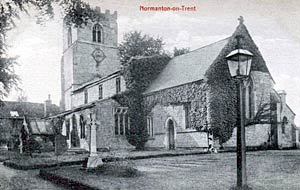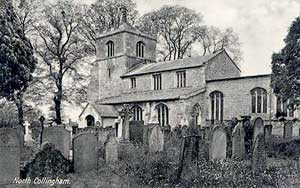< Previous | Contents | Next >

Normanton-on-Trent church, c.1905.
NORMANTON-ON-TRENT. It has on each side of it a stream flowing to the Trent, gay gardens, and a neat little church. On one side of the churchyard is a fine row of yews and beeches, through which we have a peep of the trim lawn and trees of the great house.
Though the church is much restored, some of it stands as it stood in medieval England, the nave arcades and the chancel arch 14th century, the tower and the clerestory 15th. The altar table is Jacobean, a stout ironbound chest is two centuries older, tracery from old bench-ends enriches new seats in the chancel, and there is old work left in the roof. The shallow bowl of a Norman font is set up in the churchyard.
By the Fleet in the Willows
NORTH COLLINGHAM. It shares some things with South Collingham, its close neighbour. Both line a stretch of the road between Newark and Gainsborough, and each has a lovely old church set in its most charming spot, built of the limestone quarried on this eastern bank of the Trent.
Both belong to a neighbourhood of ancient story. South-east is Brough, the site of a Roman station on the Fosse Way. East of the villages, still on the Fosse Way, is the grassy slope of Potter's Hill with a tumulus, and just below the Hill between 60 and 70 skeletons were found a century ago.

The Butter Cross, North Collingham, c.1905.

North Collingham church, c.1905.
Hobnobbing with the gawky symbol of the Petrol Age are the remains of North Collingham's 14th century cross, so enormous that it dwarfs the window of the garage that has crept up to it. Its three feet of shaft with traces of carving rests on a huge stone and a flight of three great steps, each 14 inches deep, the bottom one nearly three yards square.
High above a quiet wayside is the church, looking down through a fine screen of elms, taller than the tower, to a pretty lane crossing the Fleet in the willows. This delightful spot has more than once been a scene of desolation, for in the churchyard wall are stones showing the height of floods which made this countryside a sea. One near the churchyard gate is the base stone of an old cross, still with its socket, and it marks the height reached by the river in the devastating flood of 1795, when the Trent and the Witham joined owing to a sudden thaw after a seven-weeks' frost; it was about five feet above the level of the road. The other stone marks the flood height of 1875, which was 21 inches lower than in 1795.
The 15th century tower has a huge buttress at one corner, and the outer moulding of its fine arch to the nave rests on two heads, one with a tranquil expression, and the other grotesque with a toothless grin. The north side of this tower arch is the oldest part of the building, coming from the end of the 12th century.
In the 15th century north porch (with a stone roof) are two 14th century coffin stones carved with praying figures. The south porch is a little younger than the north; both shelter fine original doors, and another old door opens to the vestry. The glory of the church is in the 13th century nave arcades with clustered pillars: the north, the older of the two, has capitals carved with leaf and scroll, and one with two corbel heads.
Above the 15th century chancel arch is a row of seven heraldic misereres reaching from wall to wall; they are over 400 years old, and were placed here when the stalls were destroyed last century. Some old beams are in the chancel roof, and the beautiful modern roof of the nave has floral bosses. There are two old piscinas, and the massive 700-year-old font has a 17th century pyramid cover with a mass of carving.
One of the windows has a choir of red-winged angels hovering above, while Our Lord in a gleaming gown of rose and gold appears to Mary kneeling in a rich blue robe. The window is in memory of Thomas Berry, the first man of the village to offer himself for the war and the first to fall. A window showing the Good Samaritan is to a doctor who died in 1915, and there is a charming group in dainty colouring of Jesus with a baby on His knee, a little maid with plaited hair standing at His side.
A lovely thing in the churchyard is a slender column with a crucifix to those who died for peace, one a nurse who lies by the gate.
